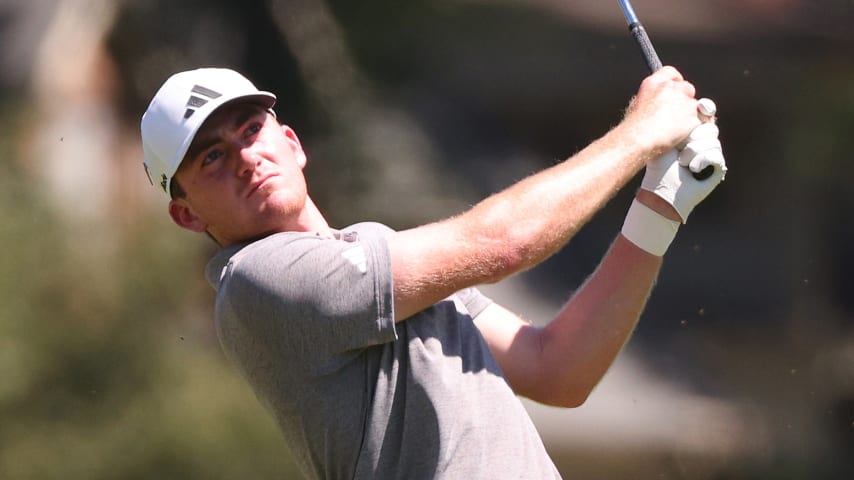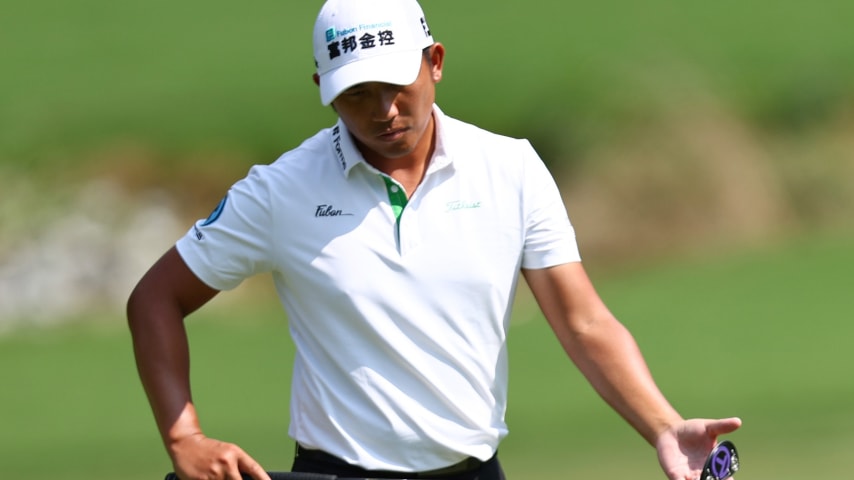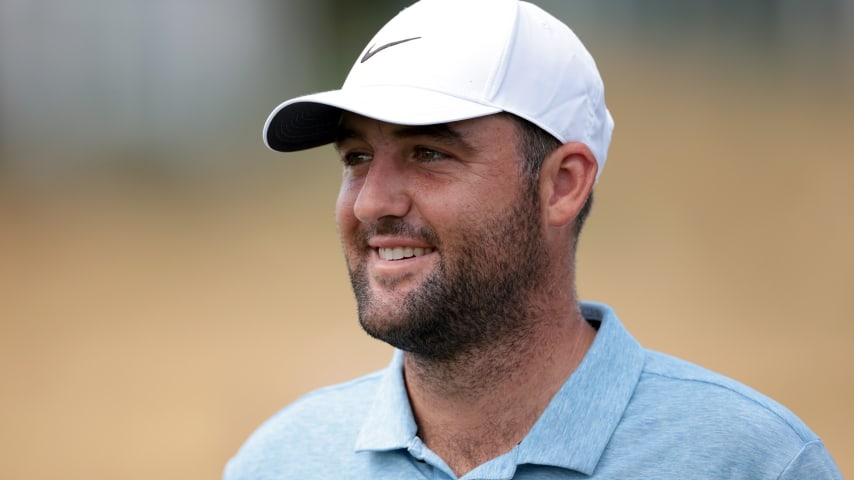Woody Austin remembers magical 2007 win at TPC Southwind
9 Min Read
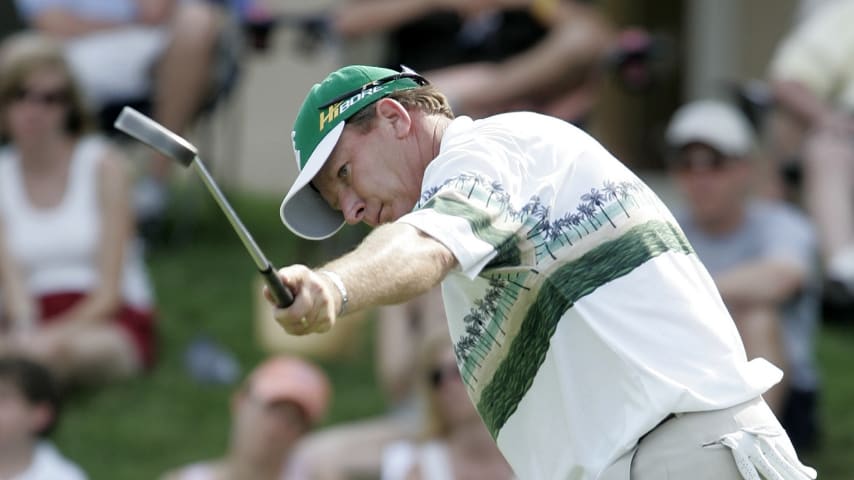
Woody Austin during the final round at TPC Southwind. (Stan Badz/PGA TOUR)
Written by Woody Austin
Editor’s Note: Woody Austin joined the PGA TOUR in 1995 after a full year playing on the Korn Ferry Tour followed by a dominating performance at the 1994 PGA TOUR Qualifying Tournament, where he rolled to a six-round, four-shot triumph. During his TOUR career, Austin played in 545 tournaments, amassing 52 top-10s, four wins and a 2007 U.S. Presidents Cup team appearance. After turning 50, in 2014, Austin joined PGA TOUR Champions and matched his four-win PGA TOUR total. When Austin won the St. Jude Classic in 2007, it was still a regular season tournament that has since become a Playoffs event—the FedEx St. Jude Championship. Seventeen years since winning at TPC Southwind, Austin reflected on a week that he punctuated with a stellar round of golf.
In 2017, I shot a 59 at the Diamond Resorts Invitational, a tournament in Orlando, Florida, that featured PGA TOUR Champions and LPGA players playing a Modified Stableford format. That 59 was pretty good. But if I’m being honest, there was a round I played, where I turned in a score three strokes higher that was actually better than the 59.
I feel that way because under the circumstances, in the environment I was in at the 2007 FedEx St. Jude Championship—and the difficulty of TPC Southwind, outside Memphis, Tennessee—that my final-round score is my best.
At that point in my career, I had previously won two PGA TOUR tournaments—the 1995 Buick Open and the 2004 Buick Championship (now the Travelers Championship). The 2007 season was the first for the FedExCup, and I was coming off a year where I finished 78th on the money list. But 2007 had not started well, and leading into Memphis, I was struggling. I had made nine of 14 cuts, but my best finish was only a tie for 18th, at the Zurich Classic of New Orleans. I had also missed two of three cuts prior to my arrival at TPC Southwind.
That set the stage for what started out as just another week on the PGA TOUR. It didn’t quite end that way.
Nothing I did in the opening round suggested good things in my future, however. I shot a 2-over 72 in the first round and needed a birdie on my final hole just to shoot that. It wasn’t only me struggling, though, which speaks to the test TPC Southwind provided. The first-round stroke average was 74.188 on the par-70 course. So even sitting at 2-over, I was only five shots behind the leaders, Freddie Jacobson and Adam Scott.
In the second round, I made my move, improving my score by six strokes. That placed me into a tie for fifth, with five other players. But we were all chasing Scott. He led by one at the halfway mark, and he was also getting the majority of the attention as the fourth-ranked player in the world.
I was No. 173.
A third-round 67 allowed me to make up some ground. Adam was still leading, ahead of Brian Gay and David Toms, by three strokes with 18 holes to play. I was four behind. The fact Scott opened 67-66-68 and seemed in full control of his game led me to believe I would have to shoot something pretty low on Sunday if I wanted to even think about winning.
Sunday, I did my part early, making a birdie on No. 2 and an eagle at the par-5 third, a perfect sand-wedge approach that I spun right into the hole from the fairway. At 3-under through three, I knew I was hitting a lot of good shots, and I was getting myself involved in the chase. After that start, my caddie, Brent Henley, said, “Don’t you dare look at a board. I don’t want you scoreboard-watching.”
In 2007, scoreboards, like today, were pretty ubiquitous, so I don’t know how people don’t look at the scoreboard. And I like to look—even when I’m in 100th place. I like to see how things are going and how people are playing. Brent felt like it would be a distraction to me, and he didn’t want me to get ahead of myself.
Brent was funny about it. Every time we came in view of a scoreboard, he would walk up to me and basically get in there between the scoreboard and me, so I couldn’t see anything. He thought he wasn’t being obvious about what he was doing, but we had been together for four years. I knew what he was up to.
I did as he told me, avoiding an occasional look, but after my fast start, I cooled off. Maybe I did get ahead of myself with my thinking as seven consecutive pars followed. Stuck in neutral, I assumed my deficit was probably about where it was at the start of the round.
The reality is Scott and I were tied, and Brent felt it was his job to ensure I didn’t know that.
I finally made my next birdie, this time at No. 10, but even at 4-under through 10, I didn’t think much of that, knowing that Nos. 2 and 3 are both birdie-able holes, which I assumed all the contenders had handled.
Then No. 12 changed everything.
After parring the 11th, I hit my approach into the par-4 12th, and I was just off the green. The bugaboo in my game has always been putting if I’m not hitting it close. For most of the front nine, I wasn’t hitting my approaches close enough, and that mean a bunch of pars. At the 12th, I wasn’t even on the green for my birdie chance. That’s when I thought that was probably a better position because I had a great lie and was no more than 20 feet from the cup. It was green light the whole way, and I hit a perfect little chip that rolled in for birdie.
OK, now I have momentum, and I know I’m in the golf tournament. After a par at 13, what I was about to do was hit the best 5-iron I’ve ever hit, and I can say that and mean it because the shot is still so vivid to me 17 years later.
At TPC Southwind, there is water trouble all over that par-3. For some reason, the rules officials changed the traditional pin placement that day. Usually, the rules guys stuck the hole in the back-right corner. But for this final round, they cut the pin on the front-right, next to the water.
My tee shot was stone dead from the tee. It never left the flag, and from where I was standing, the ball looked like it settled against the hole, on the lip. It didn’t, but it was close—just a foot away. I also knew because of the difficulty of that hole and the pin placement, had I been off by even a few feet on the line I took, the ball would have gone in the water. After my tap-in, I’m now 6-under for the day and 11-under overall.
At the same time, I was making my move, Adam was bogeying No. 13 behind me. The 14th also bit Adam as he made triple bogey there. His 4-over stretch basically ended the tournament for him and left me in the driver’s seat. Knowing Southwind well, I understood 13 and 14 were what I needed to get past. That’s where the danger was.
By the time I got to the 16th, I went against Brent’s wishes and peeked at the scoreboard (not that I told him), and I saw that I was three ahead, and it wasn’t Adam behind me. It was Brian Davis.
It’s pretty well documented that I’m a nervous player. You can hide your nerves because you don’t look nervous with a full swing. But when you have a three-footer and you miss the entire hole, that’s when people can see how nervous you are. And that’s when the difficulty in my game always arose. At times in my career, I tried to make those putts without the proper pace control because of my nerves.
I was nervous, as usual, but that particular Sunday things were a bit different. For me to shoot a really low score, I need to have a couple of dead tap-ins for birdie and easy two-putts on par-5s during a round. That’s what happened that day at Southwind—the hole-out from the fairway and the chip-in from just off the green. I didn’t have to pull out my putter on either hole. Oh, and there was also the kick-in birdie on No. 14. The nerves never had a chance to take over, or, maybe I just happened to control them.
At the 16th, I hit a perfect drive, which was huge, and I had a 3-iron approach that I hit to the middle of the green. I two-putted there for birdie, and I was rolling. How confident was I? Let’s put it this way: I knew I was in control of the tournament, and I still hit a cut off the water on the 18th, which I absolutely flushed. Not the safest of shots, but that’s how secure I felt.
As we walked down the fairway, Brent looked at the scoreboard and said, “Where do you think you’re at?” I replied with, “I’m probably up by a couple, which I knew had to be true because of my earlier glance at the scoreboard.
“You’re up four,” he said, and we both smiled.
I put my 8-iron approach into the middle of the green, two-putted for par—my 23rd and 24th putts of the day—and went on my merry little way, shooting an 8-under 62.
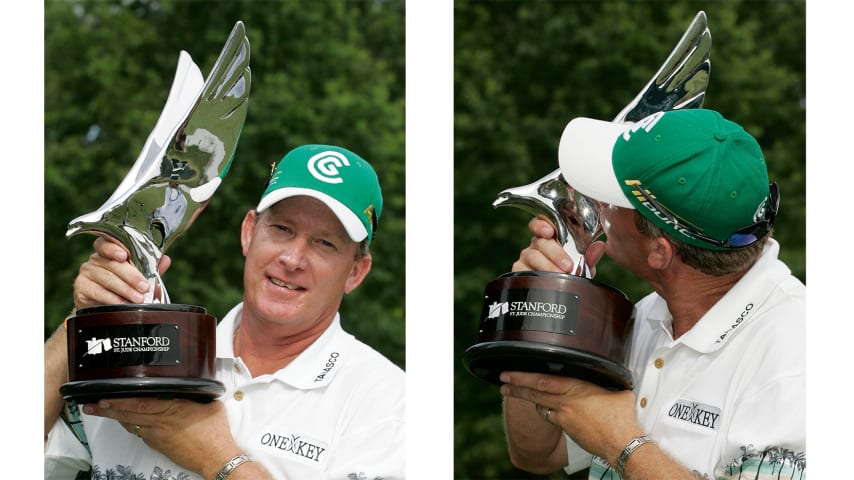
Woody Austin poses with the trophy after his win at TPC Southwind. (Stan Badz/PGA TOUR)
That week, the next-lowest score to mine was Marco Dawson’s second-round 65. For the entire PGA TOUR season, TPC Southwind played as the sixth-most-difficult course. Only the four major championship venues and Firestone Country Club, home of the WGC-BridgestoneInvitational, were harder. On Sunday, I was nine strokes better than the field average of 71.00.
I won four times on the PGA TOUR, my win in Memphis my third title. The disdain I have for my career is I didn’t win enough. I didn’t show winning talent as often as I would have liked, talent I felt I had.
At the 2007 FedEx St. Jude Championship, I did win. I began the final round down four and ended up winning by five. That’s a decent flip of the scoreboard all because of a 62 that is still my all-time best round of golf.










